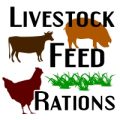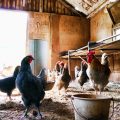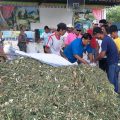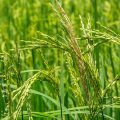The rapid development in recent years of Asia’s livestock industry has been matched by the huge increase in the importation of livestock feed. Feed costs are not only a burden on the national budget of nearly every Asian country, they are also a burden on the budget of livestock farms, where they are often 60% or more of total production costs. Even in Thailand, which is one of the few Asian countries to produce a surplus of feed materials, small-scale farmers often cannot afford enough feed to maintain their livestock in good condition over the dry season. Throughout the region, cost and availability of feed are probably the most important constraint to increased livestock production.

Since feed costs are the major part of production costs in Asia, an increase in the use of indigenous feed resources is an important way of helping farmers reduce their costs. It can also be expected to add value to indigenous resources which at the moment have little or no productive use, helping to boost farm incomes. We need to know more about potential feed resources, and also more about the constraints which have limited their use by farmers so far.
Two Kinds of Farmers Will Benefit
Increased use of indigenous feed resources is likely to benefit two types of producer in Asia. One group is the commercial producers raising high-performance animals, using mainly imported concentrates. In the past, both the livestock breeds and the concentrate feeds used for commercial raising in Asia have been much the same as those used in livestock raising in industrialized temperate countries. Now the situation is changing, and just as there is a growing interest in improved indigenous breeds better adapted to Asian conditions, so there is a growing use of locally produced feed resources. These include treated rice straw and other crop residues, silage made from pasture grasses grown as part of a complex cropping system, and waste products from agroindustry.
The second group comprises the smallholders who make little use of commercial feeds and rely on locally available forage and grasses to feed their livestock. While these local resources may be adequate at times, there is often a seasonal feed shortage which limits the overall carrying capacity of land and reduces animal productivity.
In the monsoon climate common in Asian countries, it is usually the dry season which is the time when livestock are most in need of a supplementary feed supply. The quality of feed at this time may be so poor that animals may lose a quarter of their body weight. The increased use of indigenous feed resources is a search, not only for new sources of livestock feed, but also for ways in which the supply of existing resources may be extended to cover a longer period. This may involve treatment such as drying or ensiling, so that surplus feed from seasons of abundance will still be available many months later when feed is scarce.
Any assessment of the potential contribution from a particular indigenous feed resource needs not just feeding trials to find whether it is acceptable to livestock, but on-farm trials to find whether it is acceptable to farmers. In some cases, collection and handling costs of indigenous feed resources are too high to make their use economic.
Crop Residues
On most smallholder farms, cropping is the main activity and livestock are secondary. Rice straw is the most abundant feed resource on Asian smallholdings, although some farms may also have abundant supplies of other crop residues such as corn stover and corn cobs, peanut straw, or sugarcane tops. All these crop residues tend to be highly lignified.
Rice Straw
Rice straw in particular is high in silica, with poor digestibility and a low crude protein content. Generally rice straw is fed when no green forage is available, and is given for maintenance rather than in any hope of increased production. The period when rice straw is fed may be the dry season, when there is insufficient soil moisture to keep green leaves alive. However, one paper presentation pointed out that smallholder livestock in Indonesia tend to eat rice straw at the time of the rice harvest or during the rainy season, when it is difficult for farmers to find the time to cut forage.
Increasing the Nutrient Value of Rice Straw
Any low-cost treatment which enhances the palatability and nutritive value of rice straw is likely to be advantageous. One practice which has been widely used for several decades is to treat rice straw chemically, particularly with urea, to increase its digestibility and palatability. Rice straw in Thailand is often sprayed with a mixture of urea and molasses, and many farmers in northern Thailand have permanent containers for treating the straw, even though their annual incomes are fairly low. There is also widespread interest in improving the feed value of rice straw by inoculating it with microorganisms. A few farmers’ cooperatives in Java, Indonesia, are treating rice straw with microorganisms from the rumen, taken direct from the slaughterhouse.
Urea treatment also improves the palatability and nutritional value of other crop residues such as soybean straw. Livestock do not find untreated soybean straw very palatable, since it is dusty and has hard stems, and Thai cattle fed only soybean straw were found to lose weight. The growth rate and feed intake increased if the straw was sprayed with molasses and urea, while a combination of urea-treated soybean straw and rice straw was found to give very good results, provided the proportion of soybean straw was at least 50%. It was suggested at the seminar that the legume component may enhance the digestibility of the rice straw by supplying additional nutrition to the microbes in the rumen, thus increasing their number and effectiveness. Even though urea is relatively cheap, it is too expensive for some low-income farmers in less industrialized countries. Most farmers in Indonesia still prefer to gather natural grasses for their livestock. They comment that if they are to buy food, it will be for their families rather than their livestock!
Chopped Palm Fronds
One interesting new development is the use of oil palm fronds in Malaysia as livestock feed, usually chopped and sometimes ensiled. Beef cattle gain weight when palm fronds make up as much as 50% of their diet, and dairy cattle and goats also do well when fed a rather lower proportion (30%) of fronds in their diet. Several participants were interested to find whether coconut fronds could be used in the same way. It was suggested that while coconut fronds would probably be equally nutritious used as a livestock feed, their removal from the tree would reduce coconut production. Fortunately, harvesting oil palm fronds does not seem to have much effect on yield.
Constraints to the Use of Crop Residues
Cost Factors
Integration of crop and livestock production which includes the use of crop residues as livestock feed seems to be most feasible when the scale is either very small, or very large. On plantations or large farms, the scale of production can make it economical to use machinery for collection and processing. On a very small scale, the use of crop residues to raise one or two livestock may not require much investment of either labor or capital. However, in the type of crop production common in most of Asia, crop residues are being produced on numerous scattered farms which may be geographically remote from areas where livestock production is concentrated. In this situation, the cost of collection and transportation is likely to be high. Another problem is that many crop by-products are seasonal, and become available all at once at the same time of the year. This means that expensive treatment and storage facilities are required if they are to be made available as a feed resource throughout the year.
Chemical Residues
Another important constraint is that most growing crops nowadays are protected from insect damage by chemical pesticides. These may leave toxic residues in the leaves and stems of plants used for livestock feed. Even heavy applications of fertilizer may be dangerous, causing high concentrations of nitrates to accumulate in leaves. Nitrate residues are particularly dangerous to cattle and other ruminants, as are the fatty acids present in some fishmeals and oil seeds. Volatile fatty acids are known to have a harmful affect on some bacteria species in the rumen, thus slowing down the fermentation of carbohydrates. Some agroindustrial by-products may be contaminated by undesirable ingredients, including molds and toxic substances.
Undesirable residues of this kind may have a harmful effect on the health and productivity of livestock, although this may be gradual, long-term, and difficult to detect. They may also contaminate animal products such as milk or meat, making them unpalatable or unfit for human consumption. If crop residues are to become more important as livestock feed, this must be taken into account when the crop is being grown. Toxic residues must be avoided in the leafy parts of the crop, in the same way as they are avoided in the edible parts used as human food. Obviously crop farmers must be given an incentive to do this, which must involve both some means of detecting toxic residues, and some transfer of the added value of healthy residues to crop producers. Already rice straw is becoming quite a valuable commodity. One paper presentation pointed out that whereas rice straw could be obtained free of charge a few decades ago in most Asian countries, it is now becoming more expensive. It is used as an industrial raw material in the manufacture of paper and other products as well as in agriculture. Japan is even importing stocks of rice straw from abroad.
Forage Production
The small size of most Asian farms limits the possibility of pasture production, but increasingly pasture and forage are being integrated into existing cropping systems.
Pasture Establishment in Korea
In Korea, rice straw is still an important source of roughage, but there is an increasing interest in forage production, sometimes in paddy fields during the off season and sometimes on hilly lands. A technique has been developed of converting hilly lands to pasture without any tillage. Although this method is cheap and gives good erosion control, pasture productivity is lower than that of cultivated pastures of introduced forage species which have been sprayed with herbicides and oversown. Italian rye grass and rye are the two main forage crops grown in Korean paddy fields. The former is more productive and can be harvested more frequently, but is limited to the south where winter temperatures are relatively mild. Forage grown in both upland fields and paddy fields is generally fed fresh to livestock or ensiled. Rye harvested for silage is sometimes prewilted and treated with formic acid to improve the quality of the silage.
Livestock Programs for Low-Income Farmers
There are a number of projects to develop livestock production as part of an improved farming system for low-income upland farmers. A project for raising native chickens has been successful in Vietnam, using locally available feed resources. A project promoting pig raising was less successful in the long term because rising feed costs were not compensated for by higher prices for pork.
Small livestock were also found to be preferable for low-income farmers in the Philippines, mainly because large ruminants are so expensive that they are too much of a risk. The SALT program in Mindanao, southern Philippines, is basically a technology for soil conservation and sustainable food production. The SALT-2 program developed in the 1980s combines livestock production with crops and forestry. About half of the arable land of each farm is planted in alley strips of leguminous forage crops such asDesmodium orGliricidia, and the forage is cut and fed to goats. The rest of the land is planted in a mixture of subsistence and cash crops, including legumes such as peanut and mungbean. Under this system, a farm of only half a hectare is able to support 12 does, and gives a net cash return of well over US$1000 by the second or third year.
Agroindustrial Byproducts
Most by-products from agroindustrial processing have a high moisture content. Although they are often palatable and rich in nutrients, they tend to ferment and spoil rapidly unless they are dried or processed in some other way. One processing by-product which is often used as livestock feed is the spent brewer’s grain left after brewing beer. Other commonly used by-products include molasses, pressed fruit wastes and beet pulp, oil meals and bran. However in many cases the oil seeds and other ingredients are imported, so the by-products cannot really be regarded as indigenous feed resources.
The refuse left after the manufacture of tofu (soybean curd) is a low-cost and nutritious feed for livestock which is widely available in several Asian countries. In Japan, 670 thousand mt of tofu refuse is produced each year, 70% of which is used as a feed for cattle or hogs. However, it has a high moisture content (around 80%), and begins to deteriorate after only half a day during warm weather. Drying the tofu wastes improves its storage life, but is too expensive to be economic. While the wastes can be used raw, this involves daily shipments from factory to farm, and is only feasible when distances are short. The best method of extending the usable life of the wastes is to ensile it. Usually the tofu wastes are shipped untreated direct to the farm, sometimes already packed into small drum silos containing 135-180 kg of refuse. Farms with their own large silos often mix the tofu wastes with dry additives such as beet pulp or rice straw. Handling operations in Japan are extensively mechanized.
Obviously processing is carried out with the quality of the manufactured product in mind, rather than the quality of the by-products. One participant from Taiwan suggested that specific centers are needed which would routinely examine agricultural by-products in order to examine their potential for feed and other uses, and work out appropriate feeding regimes. Several dairy and beef cooperatives in Taiwan are now planning to establish centers for the preservation of agricultural by-products. These centers will be located near cooperative farms, and will provide silage to farmers, as well as directions on how to use the materials in feed rations.
Conclusion
Any use of indigenous feeds must meet the same requirements as livestock feeds from other sources. Such feeds must not only be palatable and digestible to livestock, without any harmful physiological effects, but they must be available where and when they are needed, and their cost must be low enough to make their use economical. Indigenous feeds are made up of two main types of materials, crop residues and agroindustrial by-products. The basic concern with crop residues is improving the feed value, which is generally low. As far as agroindustrial wastes are concerned, the main problem is their high water content and short storage life unless they are given some form of processing such as drying.
New materials are being explored, particularly agroindustrial by-products but also improved forage species. Oil palm fronds are a promising new resource, while 3000 mt of seaweed is being shipped to Japan from the Philippines each year as a feed material. A database of existing feed materials in Asian countries would be a valuable asset.
Agroindustrial wastes are a frequent cause of pollution. Possibly the cost of processing them into livestock feed should be shared by the processors. In general, economics rather than technology seems to be the major constraint in making increased use of indigenous feed resources. Even crop residues which have no other economic use may not be a very cheap source of livestock feed if the costs of collection, transportation and storage are taken into account.
Transfer to farmers of information on indigenous feed resources is another weak point. Low-income farmers would be helped by small inexpensive machines for chopping feed materials etc., while more exploitation of leaf meals, possibly in pelletized form, might also benefit this group. Cooperatives can be another way in which small-scale farmers can increase the efficiency and scale of their use of local feed resources. For example, many forage producers in Korea have organized themselves into small cooperative groups to share the cost and use of machinery.
Index of Images
Source: Food & Fertilizer Technology Center – Agnet.org







Amazing! Small-scale farmers in Thailand, one of the few Asian countries with a wealth of feed materials, typically cannot afford enough feed to keep their cattle in excellent health during the dry season.